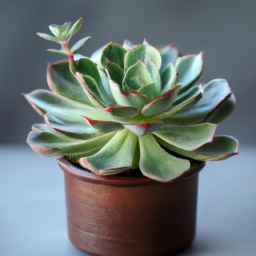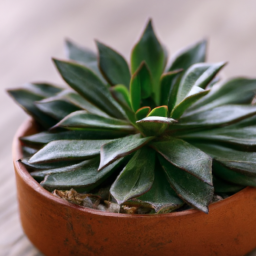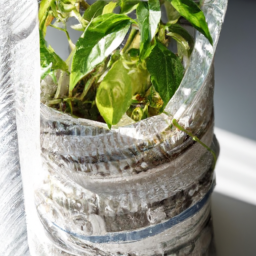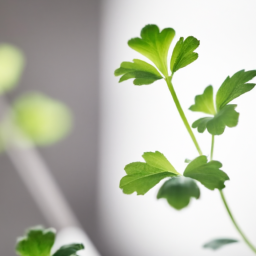
Are you looking to take your succulent game to the next level? If so, you’ve come to the right place! In this blog post, we’ll be diving into the world of grow lights for succulents. Whether you’re a seasoned plant parent or just starting out, understanding the importance of proper lighting for your succulents is key to their overall health and growth. So, grab your favorite succulent and let’s shed some light on this topic together!
Benefits of Using Grow Lights for Succulents
Hey there succulent lovers! Are you looking to take your succulent game to the next level? Well, look no further than using grow lights to help your precious plants thrive. In this guide, we’ll explore the numerous benefits of using grow lights for succulents and how you can set up your own grow light system for maximum success.
Increased Growth and Health
One of the biggest benefits of using grow lights for your succulents is the increased growth and overall health of your plants. Succulents thrive in bright, indirect sunlight, and grow lights provide the perfect artificial light source to mimic these conditions. With the right spectrum of light, your succulents will grow faster, stronger, and more vibrant than ever before.
Grow lights also help prevent etiolation, which is when succulents become stretched out and leggy due to lack of sunlight. By providing consistent light to your plants, you can ensure they maintain a compact and healthy growth habit.
Additionally, grow lights can help stimulate flowering in certain succulent species, leading to a beautiful display of blooms that you may not have otherwise seen. So if you want your succulents to reach their full potential, investing in a quality grow light is definitely worth it.
Extended Growing Season
Another great benefit of using grow lights for succulents is the ability to extend the growing season year-round. In areas with short daylight hours or harsh winters, grow lights allow you to provide your succulents with the light they need to continue growing and thriving, even when natural sunlight is scarce.
With a grow light system in place, you can keep your succulents happy and healthy no matter the season, giving you the flexibility to grow a wider variety of plants and experiment with different species that may not be well-suited to your local climate.
By providing consistent light and maintaining optimal growing conditions, you can keep your succulents looking their best all year long and enjoy a never-ending gardening experience that brings joy and satisfaction to your green thumb.
Customizable Light Intensity and Duration
One of the key advantages of using grow lights for succulents is the ability to customize the light intensity and duration to meet the specific needs of your plants. Different succulent species have varying light requirements, so having control over the light output of your grow lights allows you to tailor the lighting conditions to suit each plant’s individual needs.
Whether you have low-light succulents that prefer gentler light or high-light succulents that crave intense sunlight, a grow light system gives you the flexibility to adjust the light intensity to ensure optimal growth and health. You can also set timers to regulate the duration of light exposure, mimicking natural daylight cycles and promoting healthy growth patterns in your succulents.
By fine-tuning the light settings to match the requirements of your succulents, you can create the perfect growing environment that maximizes their potential and enhances their beauty. So don’t be afraid to experiment with different light levels and schedules to see what works best for your beloved plants.

Choosing the Right Grow Light for Your Succulent Plants
Understanding the Different Types of Grow Lights
When it comes to choosing the right grow light for your succulent plants, it’s important to understand the different types of grow lights available on the market. There are three main types of grow lights that are commonly used for indoor gardening: fluorescent, LED, and HID (high-intensity discharge) lights.
Fluorescent lights are a popular choice for indoor gardening because they are affordable and energy-efficient. They come in two main types: T5 and T8. T5 lights are more powerful and efficient than T8 lights, making them a better choice for growing succulents. However, T8 lights can still be effective for smaller succulent plants.
LED lights are another popular choice for indoor gardening. They are energy-efficient, long-lasting, and produce very little heat. LED lights come in a variety of colors, including red, blue, and white, which can be tailored to the specific needs of your succulent plants.
HID lights are the most powerful grow lights available on the market. They produce a lot of heat and light, making them ideal for larger succulent plants that require a lot of light to thrive. However, HID lights can be expensive to purchase and operate, so they may not be the best choice for all indoor gardeners.
Factors to Consider When Choosing a Grow Light
When choosing a grow light for your succulent plants, there are several factors to consider to ensure that your plants receive the right amount of light to thrive. One important factor to consider is the light intensity of the grow light. Succulent plants require bright, indirect light to grow and thrive, so it’s important to choose a grow light that provides the right amount of light for your plants.
Another factor to consider is the color temperature of the grow light. Different types of plants require different color temperatures to grow and thrive. Succulent plants typically require a grow light with a color temperature of around 5000-6500K, which mimics the natural light of the sun.
The size and shape of your succulent plants will also play a role in determining the right grow light for your indoor garden. Smaller succulent plants may only require a small, low-wattage grow light, while larger succulent plants may require a more powerful grow light to ensure that they receive enough light to thrive.
Tips for Using Grow Lights for Your Succulent Plants
When using grow lights for your succulent plants, it’s important to position the lights correctly to ensure that your plants receive the right amount of light to grow and thrive. Place the grow lights at a distance of 6-12 inches above your succulent plants to ensure that they receive enough light without burning the leaves.
It’s also important to provide your succulent plants with a consistent light cycle to mimic the natural light of the sun. Most succulent plants require around 12-14 hours of light per day to grow and thrive. Use a timer to ensure that your grow lights turn on and off at the same time each day to provide your plants with a consistent light cycle.
Finally, be sure to monitor your succulent plants regularly to ensure that they are receiving the right amount of light to thrive. If your plants are not growing or are starting to look leggy, it may be a sign that they are not receiving enough light. Adjust the position of your grow lights or increase the light intensity to ensure that your succulent plants receive the light they need to thrive.

Tips for Properly Caring for Succulents with Grow Lights
Understanding the Basics of Succulents
Succulents are a popular choice for indoor plants due to their unique appearance and low maintenance requirements. These plants have thick, fleshy leaves and stems that store water, allowing them to survive in dry conditions. However, when grown indoors, succulents may not receive enough sunlight to thrive. This is where grow lights come in handy.
When choosing a grow light for your succulents, it’s important to consider the light intensity, color temperature, and duration of exposure. Succulents require bright, indirect light to grow properly. A grow light with a color temperature of around 6500K is ideal for mimicking natural sunlight. Additionally, it’s recommended to provide your succulents with 12-16 hours of light per day to promote healthy growth.
Choosing the Right Grow Light
There are various types of grow lights available on the market, including fluorescent, LED, and high-intensity discharge (HID) lights. LED grow lights are a popular choice for succulents due to their energy efficiency and customizable light spectrum. When selecting a grow light for your succulents, consider the size of your plant collection and the space available for installation.
For small succulent arrangements, a compact LED grow light panel may be sufficient. However, if you have a larger collection, you may opt for a full-spectrum LED grow light fixture that can cover a wider area. It’s important to position the grow light at the correct distance from your succulents to prevent burning or stretching. Generally, LED grow lights should be placed 6-12 inches above the plants for optimal results.
Caring for Succulents Under Grow Lights
Once you have set up your grow light system, it’s essential to monitor your succulents regularly to ensure they are receiving adequate light and water. Succulents grown under artificial light may require more frequent watering compared to those grown outdoors. Check the soil moisture levels regularly and adjust your watering schedule accordingly.
In addition to proper watering, it’s important to fertilize your succulents regularly to provide essential nutrients for growth. Use a balanced liquid fertilizer diluted to half strength and apply it to your plants every 2-4 weeks during the growing season. Avoid over-fertilizing, as this can lead to nutrient imbalances and damage to your succulents.
By following these tips for properly caring for succulents with grow lights, you can create a thriving indoor garden filled with beautiful and healthy plants. Remember to adjust the light intensity, color temperature, and duration of exposure based on the specific needs of your succulents to ensure optimal growth and development.
Summary Snapshot
Succulents have become increasingly popular as houseplants due to their unique shapes and low-maintenance care requirements. However, one common challenge that succulent owners face is providing adequate lighting for their plants, especially in areas with limited natural sunlight. This is where grow lights come in handy, as they can help supplement the light requirements of succulents and promote healthy growth.
Grow lights for succulents come in various types, including fluorescent, LED, and high-intensity discharge (HID) lights. Each type has its own advantages and considerations, such as energy efficiency, light intensity, and cost. When choosing a grow light for your succulents, it’s important to consider factors like the size of your plant collection, the space available for lighting fixtures, and your budget. By providing your succulents with the proper lighting conditions, you can ensure that they thrive and continue to bring beauty to your indoor space.
Check Out These FAQs:
Q1. What type of grow light is best for succulents?
A1. The best type of grow light for succulents is a full spectrum LED grow light. This type of light provides the necessary wavelengths of light that succulents need for optimal growth.
Q2. How far should the grow light be from succulents?
A2. It is recommended to place the grow light about 6-12 inches away from the succulents. This distance will ensure that the plants receive enough light without getting burned.
Q3. How long should I leave the grow light on for succulents?
A3. Succulents typically need about 12-16 hours of light per day. You can use a timer to ensure that the grow light is on for the correct amount of time each day.
Q4. Can I use a regular light bulb as a grow light for succulents?
A4. Regular light bulbs do not provide the necessary spectrum of light that succulents need for proper growth. It is best to use a full spectrum LED grow light specifically designed for plants.
Q5. Do succulents need darkness at night?
A5. Yes, succulents do need a period of darkness at night to rest and recover. It is important to provide them with a consistent light schedule that includes both light and dark periods for optimal growth.
Dr. Olivia Green is a botanist with over two decades of experience in indoor plant cultivation. She holds a Ph.D. in Plant Biology and has dedicated her career to researching plant behavior in controlled environments. Dr. Green is passionate about helping plant enthusiasts master the art of indoor gardening through her extensive knowledge and practical insights.


